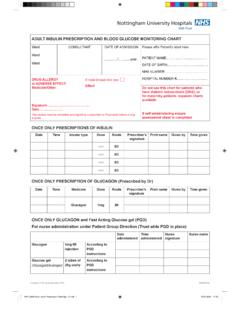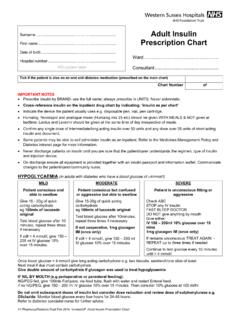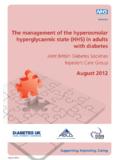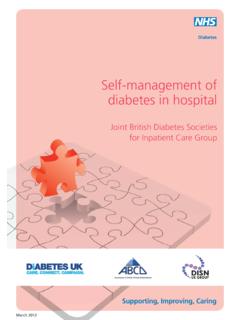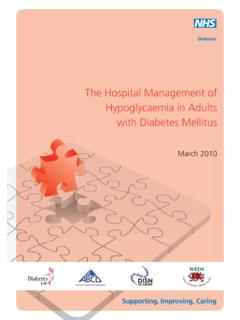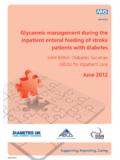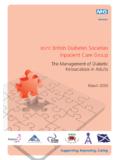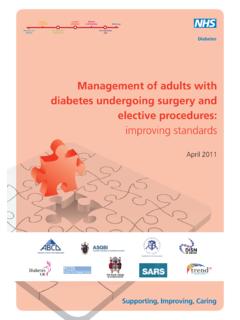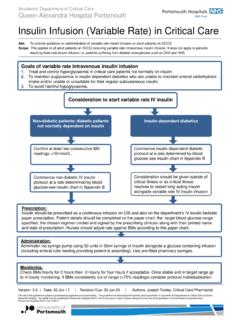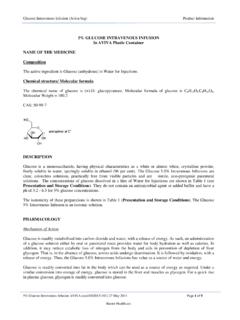Transcription of The use of variable rate intravenous insulin infusion ...
1 The use of variable rate intravenous insulin infusion ( vriii ) in medical inpatients October 2014. This document is coded JBDS 09 in the series of JBDS documents: Other JBDS documents: Management of Hyperglycaemia and Steroid (Glucocorticoid) Therapy October 2014 JBDS 08. Admissions avoidance and diabetes: guidance for clinical commissioning groups and clinical teams December 2013 JBDS 07. The management of the hyperosmolar hyperglycaemic state (HHS) in adults with diabetes August 2012 JBDS 06. Glycaemic management during the inpatient enteral feeding of stroke patients with diabetes June 2012 JBDS 05. Self-Management of Diabetes in Hospital March 2012 JBDS 04. Management of adults with diabetes undergoing surgery and elective procedures: improving standards April 2011 JBDS 03.
2 The Management of Diabetic Ketoacidosis in Adults Revised September 2013 JBDS 02. The Hospital Management of Hypoglycaemia in Adults with Diabetes Mellitus Revised September 2013 JBDS 01. These documents are available to download from the ABCD website at and the Diabetes UK website at We are eager to find out about your experiences using this guideline- particularly any data from audits of its use in situ. This will be used in the next update of the guideline. Please contact Dr Stella George at: Scope of the guideline This guideline is for the use of a variable rate intravenous insulin infusion ( vriii ) in adult inpatients with medical conditions and diabetes/hyperglycaemia, who require intravenous administration of insulin to keep their blood glucose within the recommended target range during an acute illness or a period of starvation.
3 This document is designed to guide non specialist teams in the appropriate and safe use of a vriii . Seek help from your local diabetes team at the earliest opportunity. This guideline is not suitable for use in certain situations. We make the following recommendations for those circumstances. Diabetic Ketoacidosis (DKA) The management of DKA in Adults [JBDS 02; March 2012, revised June 2013]. or Hyperosmolar hyperglycaemic State (HHS) The management of the hyperosmolar hyperglycaemic state [JBDS 06; August 2012]. or Patients who are perioperative or are undergoing Management of adults with diabetes undergoing procedures requiring a period of starvation surgery and elective procedures: improving standards [JBDS 03; April 2011] currently being updated or Patients who require enteral feeding who Glycaemic management during the inpatient enteral have suffered a stroke feeding of stroke patients with diabetes [JBDS 05; June 2012].
4 Or Acute Coronary Syndrome Use local guideline Patients requiring Total Parenteral Nutrition Use local guideline Antenatal patients Use local guideline Patients who are hyperglycaemic due to steroid Use local guideline- JBDS guideline in development therapy 3. Abbreviations used in this guideline Term Abbreviation variable rate intravenous insulin infusion vriii . Capillary blood glucose CBG. Diabetic Ketoacidosis DKA. Hyperosmolar Hyperglycaemic State HHS. Total Parenteral Nutrition TPN. Continuous Subcutaneous insulin infusion CSII. Total Daily Dose TDD. Sodium Chloride NaCl Potassium Chloride KCl National Institute of Clinical Excellence NICE. 4. Lead authorship Dr Stella George, Consultant Diabetes and Endocrinology, East and North Hertfordshire NHS Trust Debbie Stanisstreet, Diabetes Inpatient Specialist Nurse, East and North Hertfordshire NHS Trust Supporting organisations Diabetes UK: Tracy Kelly, Head of Care Joint British Diabetes Societies (JBDS) for Inpatient Care, Chair: Professor Mike Sampson (Norwich).
5 Diabetes Inpatient Specialist Nurse (DISN) UK Group, Chair: Esther Walden (Norwich). Association of British Clinical Diabetologists (ABCD), Chair: Dr Rob Gregory (Leicester). Endorsed by Diabetes Frail The Diabetes Management and Education Group (DMEG) of the British Dietetic Association Royal College of Physicians (RCP). The Renal Association The Society for Acute Medicine (SAM). UK Clinical Pharmacy Association (UKCPA) Diabetes and Endocrinology Committee Writing group Dr Ali Abbara, Imperial Healthcare College NHS Trust Linda Balian, Yeovil District Hospital NHS Foundation Trust Dr Mithun Bhartia, Sandwell and West Birmingham Hospitals NHS Trust Alison Cox, Kings College Hospital NHS Foundation Trust Dr Frances Coyle, Frimley Park Hospital NHS Foundation Trust Anne Currie, East and North Hertfordshire NHS Trust Dr Jane Dale, The Dudley Group NHS Foundation Trust Dr Ketan Dhatariya, Norfolk and Norwich University Hospitals NHS Foundation Trust Dr Philip Dyer, Heart of England NHS Foundation Trust Dr Haleema Hayat, Burton Hospitals NHS Foundation Trust Dr Anne Kilvert, Northampton General Hospital NHS Trust Dr Abbi Lulsegged.
6 Kings College Hospital NHS Foundation Trust Dr Samson Oyibo, Peterborough and Stamford Hospitals NHS Trust Tobi Parkin, Northern Devon Healthcare NHS Trust 5. JBDS IP Group Dr Belinda Allan, Hull and East Yorkshire Hospital NHS Trust Dr Hamish Courtney, Belfast Health and Social Care Trust, Northern Ireland Dr Ketan Dhatariya, Norfolk and Norwich University Hospitals NHS Foundation Trust Dr Daniel Flanagan, Plymouth Hospitals NHS Trust Dr Stella George, East and North Hertfordshire NHS Trust Dr Rob Gregory, University Hospitals of Leicester NHS Trust June James, University Hospitals of Leicester NHS Trust Tracy Kelly, Diabetes UK. Dr Rif Malik, King's College Hospital NHS Foundation Trust Dr Colin Perry, NHS Greater Glasgow and Clyde Dr Gerry Rayman, The Ipswich Hospitals NHS Trust Dr Stuart Ritchie, NHS Lothian Dr Aled Roberts, Cardiff and Vale University Health Board Professor Mike Sampson (Norwich), Chair, Joint British Diabetes Societies (JBDS)
7 For Inpatient Care Dr Maggie Sinclair-Hammersley, Oxford University Hospitals NHS Trust Debbie Stanisstreet, East and North Hertfordshire NHS Trust Professor Jonathan Valabhji, National Clinical Director for Obesity and Diabetes Esther Walden, Norfolk and Norwich University Hospital NHS Foundation Trust Dr Peter Winocour, East and North Hertfordshire NHS Trust With special thanks to Christine Jones for her administrative work and help with these guidelines and with JBDS IP. 6. Contents Page Foreword 9. Introduction 10. Chapter 1: Background and definitions 11-12. Background 11. Definition of variable rate intravenous insulin infusion 11. Classification of hyperglycaemia in acutely unwell patients 11. The use of vriii in UK hospitals 11. The National Diabetes Inpatient Audit 11.
8 Dynamic Sliding Scale intravenous insulin Regimes 12. Combined Glucose, Potassium, insulin infusion Regimes 12. Chapter 2: Evidence base for recommendations 13-17. Evidence for adverse effect of hyperglycaemia on 13. outcomes during illness Evidence for specific blood glucose targets 13. Glycaemic control in intensive care units 13-14. Glycaemic control in hospitalised patients in non ICU 14. settings Glycaemic control in acute myocardial infarction 14. Glycaemic control in stroke 14. Guidelines from national and international societies 14. Summary of Evidence 17. Chapter 3: Recommendations for use of vriii 18-26. Indications for vriii in medical patients 18. Advantages of a vriii 19. Disadvantages of a vriii 19. Potential risks of a vriii 19. Practical aspects of setting up a vriii 19-21.
9 Setting up a vriii 19. Suggested infusion rates 20-21. Treatment of Hypoglycaemia during a vriii 21. Maintaining safety during the use of a vriii 21. 7. Frequency of measurement and targets for capillary 21-23. blood glucose monitoring Measurement of capillary blood ketones 22. Frequency of clinical patient review 22. Choice of concurrent fluids 33. Factors affecting the choice of fluid and rate of infusion 23. Recommended fluid 23-24. Duration of vriii 25. Management of other diabetes medications during a vriii 25. Transferring from a vriii to subcutaneous insulin and/or oral 25. treatment Safe use of insulin 26. Chapter 4: Special circumstances 27-28. Patients on total parenteral nutrition 27. Monitoring 27. Delivery 27. Cautions 27. Stepping down from a vriii in patients on total 27.
10 Parenteral nutrition Patients on continuous subcutaneous infusion pumps 27-28. Appendices Appendix 1: How to set up a vriii 29. Appendix 2: Safe discontinuation of a vriii 30-38. Appendix 3: Management of hyper and hypoglycaemia 39-40. following discontinuation of the vriii . Appendix 4: Quick reference tool for the use of a vriii 41-43. References 44-47. 8. Foreword It is recognised that the use of a variable rate intravenous insulin infusion ( vriii ) is a tool commonly used to achieve normoglycaemia in hospital inpatients. Most acute trusts have guidelines for its use, but there is a wide variation across the country in, for example, the indications for its use, in rates of infusion , or duration of use. This heterogeneity increases the risk of errors which can potentially lead to significant morbidity and mortality.
